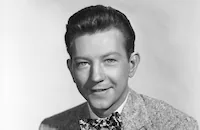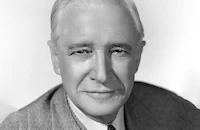Mister Big
Brief Synopsis
Cast & Crew
Charles Lamont
Gloria Jean
Donald O'connor
Peggy Ryan
Robert Paige
Elyse Knox
Film Details
Technical Specs

Synopsis
Jeremy Taswell is the director of the Davis School of the Theatre, a private high school for the arts. The faculty includes young lovers Johnny Hanley and Alice Taswell. One afternoon, student Donald suggests to some of his classmates that they go to "Jimmy's Backyard," a local hot-spot where Ray Eberle and His Orchestra, a jive band, is playing. While the teenagers are having a grand time, they discover from the band leader that their instructor, Johnny, is also known as "Boogieman Blue," a hot new songwriter. Donald tells Johnny that he has written a musical comedy, and fellow student Patricia, whose aunt, Mary Davis, owns the school, offers to use her influence to get the show produced. Aunt Mary, however, is a "culture nut," and becomes incensed at the mere thought of a "jive" show being produced at her school. After Aunt Mary reminds her niece that she is studying to be a dramatic actress, not a "jitterbugger," the students sadly learn that Sophocles' Antigone has been selected as the official class play. When Aunt Mary leaves for New York, however, the students go to work on Taswell, and, with the help of Johnny and Alice, he agrees to allow them to produce Donald's show, as long as Patricia is given a role. Johnny then writes the music for the show, which has become a musical version of Antigone . Donald tutors Patricia in jive dancing, and despite the reservations of the other students, who think she is too high-brow, gives her a featured part in the show. On opening night, Patricia breaks the bad news that her aunt has returned from New York. The students and faculty decide to put on Donald's show, even though Aunt Mary insists on seeing the original Antigone , as she has invited some society friends who might endow the school. The play opens, with Eberle's Broadway producing friends in the audience. Aunt Mary's friends are missing, however, as Donald has gone to the railway station and detoured them from the school. He returns just in time to see Aunt Mary's reaction to the first musical number. He convinces her that it is classical African music, then talks her into leaving the show to search for her friends. Unfortunately, they return to the theater just in time to see the jitterbug finale, which infuriates Aunt Mary. The Broadway producers, however, are enthralled with the show and offer to produce it in New York. Aunt Mary immediately changes her mind about the production and offers her full support. Johnny and Alice have fallen even deeper in love, while Donald finally returns Patricia's affection by offering to take her out for an ice cream soda.

Director
Charles Lamont
Cast

Gloria Jean

Donald O'connor

Peggy Ryan

Robert Paige
Elyse Knox

Samuel S. Hinds
Bobby Scheerer
Richard Stewart
Mary Eleanor Donahue

Florence Bates
Ray Eberle
Eddie Miller's Bob Cats
The Ben Carter Choir
The Jivin' Jacks And Jills

Irving Bacon
William Ruhl
Alan Ward
Jimmy Lucas

Emmett Vogan
Claire Whitney

Bess Flowers
Jean Inness
Crew
Dorothy Bennett
Ben Black
Bernard B. Brown
Hughie Charles
Howard Christie
Eugene Conrad
Louis Da Pron
R. A. Gausman
Harry Gifford
Ken Goldsmith
John Goodman
Frank Gross
Inez James
Edwin H. Lamare
A. J. Lawrence
Harold Macarthur
Tom Mellor
Neil Moret
Ross Parker
Buddy Pepper
Jack Pollexfen
Charles Previn
Robert Pritchard
E. R. Robinson
George Robinson
Mel Ronson
Virginia Rooks
Milton Schwarzwald

Film Details
Technical Specs

Articles
Peggy Ryan (1924-2004)
Born Margaret O'Rene Ryan on August 28, 1924, in Long Beach, California, Ryan began dancing professionally as a toddler in her parents' vaudeville act, the Dancing Ryans, and was discovered by George Murphy when she was 12. Murphy arranged for young Peggy to dance with him in the Universal musical Top of the Town (1937). She would go on to make a few more film appearances over the next few years - the most striking of which as a starving, homeless girl in John Ford's The Grapes of Wrath (1940) - yet for the most part, she was hardly noticeable apart from a few dance numbers.
Her luck changed when Universal cast her opposite another teenage hoofer, Donald O'Connor in What's Cookin'? (1942). From then on, they teamed in a series of innocuous musicals that were low on production values, but high on youthful pluck. Just check out some of their titles: Private Buckaroo, Give Out, Sisters!, Get Hep to Love (all 1942); Top Man, Mr. Big (both 1943); Chip Off the Old Block, This Is the Life, and Bowery to Broadway (all 1944). They may have not been high art, but jitterbuggin' kids loved it, and given the low investment Universal put into these pictures, they turned quite the profit.
Her career slowed down after the war. In 1945, she married songwriter James Cross, and didn't return to films until 1949, when she made two minor musicals that year: Shamrock Hill, There's a Girl in My Heart. She divorced Cross in 1952 and met her second husband, dancer Ray McDonald, in her final film appearance, a forgettable musical with Mickey Rooney, All Ashore (1953). Tragically, McDonald died in 1957 after a food choking incident, and the following year, Ryan moved to Honolulu after marrying her third husband, Honolulu Advertiser columnist Eddie Sherman. She kept herself busy teaching dance classes at the University of Hawaii, but in 1969, she found herself back in front of the camera as Jenny Sherman, secretary to Detective Steve McGarrett (Jack Lord) on the long-running show Hawaii Five-O,. She played the role for seven years, remaining until 1976.
Eventually, Ryan relocated with her husband to Las Vegas, where for the last few years, she was teaching tap dancing to a whole new generation of hoofers. She is survived by her son, Shawn; daughter Kerry; and five grandchildren.
by Michael T. Toole

Peggy Ryan (1924-2004)
Quotes
Trivia
Notes
The working titles of this film were Oh, Say, Can You Swing?, You Can't Ration Love and School for Jive. According to Hollywood Reporter, the film's release title was changed from School for Jive to Mister Big in order to promote rising Universal star Donald O'Connor. Universal press materials further state that Mister Big was designed to be the first "star vehicle" for O'Connor. A February 5, 1943 Hollywood Reporter news item announced a planned Universal project entitled Benny Goes to Town, starring O'Connor, Gloria Jean, Peggy Ryan and Bobby Scheerer, and directed by Charles Lamont. It has not been determined if this project became Mister Big or was another project that was replaced on the Universal production schedule by Mister Big. Mister Big marked the feature film debut of child actress Mary Eleanor Donahue.














